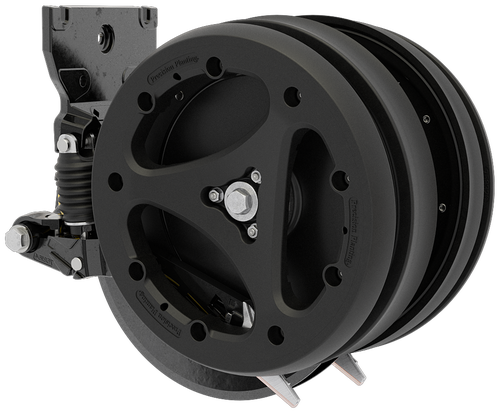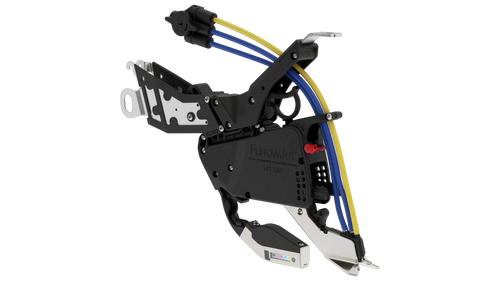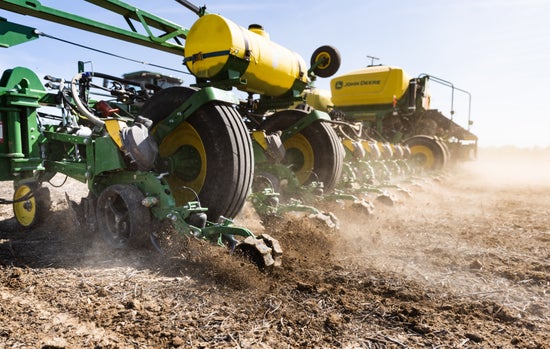
Key Points
- Objective: This 7-year long-term study evaluates the performance of nine different nitrogen rate and placement programs. These nine programs consist of single one-and-done nitrogen programs, 2-way split applications, and even 3-way split programs. All treatments are applied using 32% UAN liquid nitrogen. As a baseline, the 50% WNF + 50% V6 Side-Dress (Treatment #4) is facilitated as the control for this trial.
- Split Application Advantages: When we are adding a dual application side-dress treatment in addition to a WNF program, it has offered 12.8 Bu/A average yield advantages. If we take this one step further, adding a planter-applied application (triple split) offered even higher average yields gains at 26.0 Bu/A.
- Highest Performer: The top nitrogen program over the 7-year period was the triple split program (Treatment #9), which has resulted in an economic increase of $48.77/A compared to the 50% WNF + 50% side-dress control (Program #4).
Single Applications:
| 1) 100% Weed-N-Feed (WNF) | 240# N as Surface applied 32% UAN | ||
| 2) 100% Conceal Single Band | 240# N with Conceal Single N Band 1.5” Deep | ||
| 3) 100% Conceal Dual Band | 240# N with Conceal Dual N Bands 1.5” Deep |
Dual Split Applications:
| 4) 50% WNF + 50% SideDress (SD) | 120# N WNF+ 120# N V6 Side-Dress “Control” | ||
| 5) 50% Conceal Single Band + 50% SD | 120# N Conceal Dual Bands + 120# N V6 SD | ||
| 6) 50% Conceal Dual Band + 50% SD | 120# N Conceal Dual Bands + 120# N V6 SD | ||
| 7) 25% Conceal Dual Band +50% SD | 60# N Conceal Dual Bands + 120# V6 SD | ||
| 8) 75% Conceal Dual Band + 50% SD | 180# N Conceal Dual Bands + 120# N V6 SD |
Triple Split Applications:
| 9) 25% Conceal + 25% WNF + 50% SD | 90# N WNF + 90# N Conceal Dual Bands + 120# SD |
In this multi-year study, we're evaluating the performance of nine (yes, nine!) different nitrogen rate and placement programs. These nine programs consist of single one-and-done nitrogen programs, 2-way split applications, and even 3-way split programs.
In this study, all treatments are applied using 32% UAN liquid nitrogen. As a baseline, the 50% WNF + 50% V6 Side-Dress (Treatment #4) is facilitated as the control for this trial.
When we average the data since 2017, the single nitrogen applications performed the lowest along with the 25% reduced rate treatment (#7: 25% Conceal Dual Band+50% SD). In contrast, the Triple Split nitrogen rate treatment (#9) saw the highest overall yield at a 243.3 Bu/A average. Our control performed at 230.1 Bu/A for comparison. Just three performed above our control group when it comes to yield.
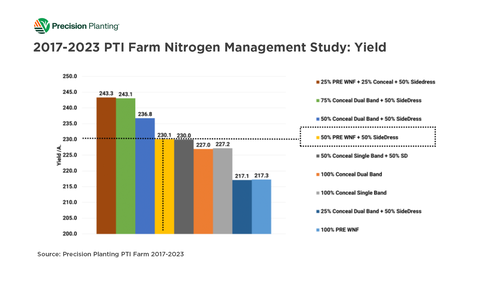
The story continues as we calculate net return after the cost of nitrogen. The top nitrogen program was the triple split program (Treatment #9) and has resulted in positive economic returns of +$48.77/A in comparison to our control.
To understand the efficiency of the applications, we evaluated adjusting the nitrogen rate by +25% and -25%. Adding 25% more nitrogen was the 2nd overall highest-yielding treatment, and also resulted in the 2nd highest overall net return after the cost of N, albeit -$21.64/A less than the top triple split program.
Lowering the nitrogen rate by 25% has turned out costly, as yields have suffered -13.0 Bu/A along with decreased returns of -$38.05/A compared to the control. However, this -25% reduced rate of N still offered +$3.57/A above the single application 100% WNF rate of nitrogen.
Overall, single application nitrogen programs posted negative economic returns of -$19.52/A, -$21.04/A, and -$34.93/A.
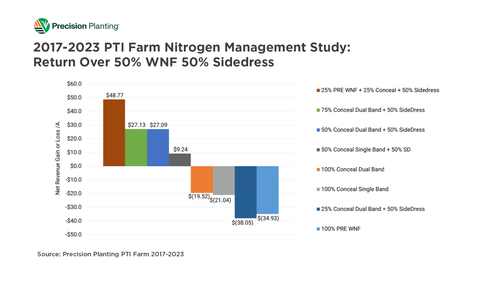
Our triple split application clearly offers the advantage with 26.0 Bu/A compared to the 100% WNF application. The dual application side-dress treatment also offered a 12.8 Bu/A yield advantage above the 100% WNF application.
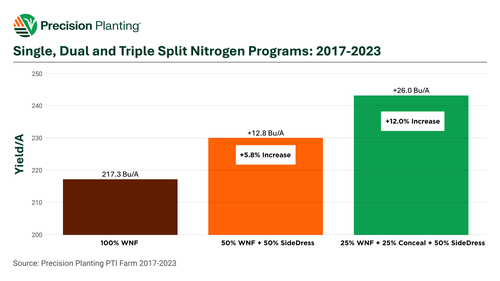
Study Details
Study data collected 2017-2023 at the PTI Farm in Pontiac, IL.
| Planting Date | Varied By Year | Rotation | CAB, CAC (2021, 2023) |
| Row Width | 30" | Population | 36K |
| Corn Prices | 2023 - $5.31 2022 - $6.00 2021 - $5.00 2020 - $3.75 2019 - $3.67 2018 - $3.50 |
